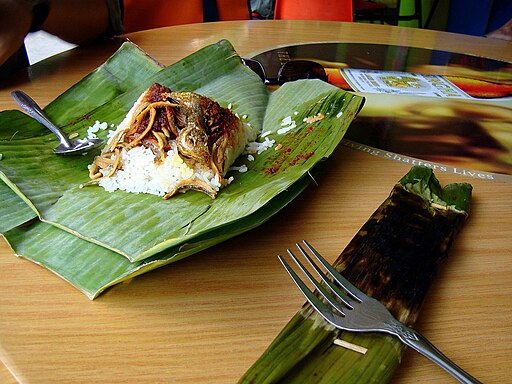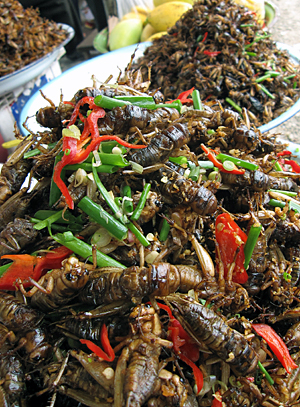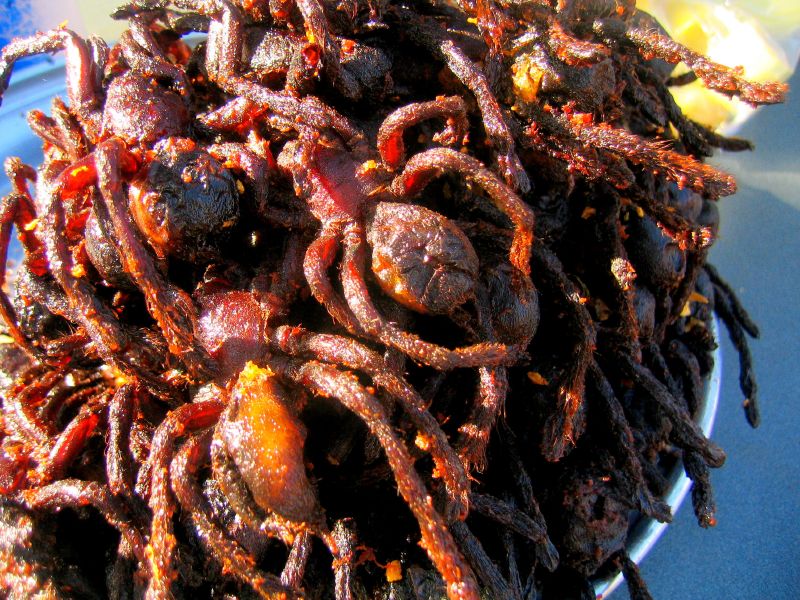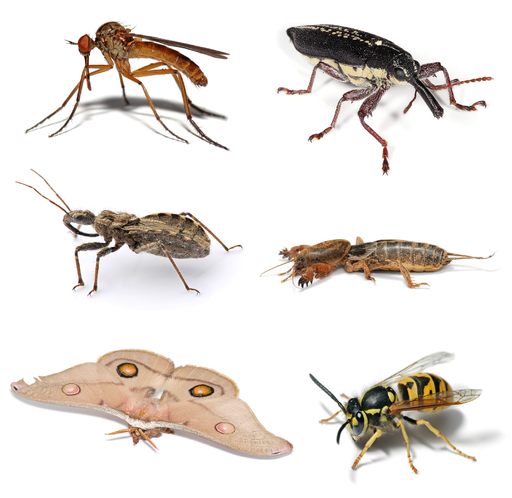
By Takeaway (Own work) [CC-BY-SA-3.0 (http://creativecommons.org/licenses/by-sa/3.0) or GFDL (http://www.gnu.org/copyleft/fdl.html)], via Wikimedia Commons
When it comes to food, Malaysians delight in national
staples like nasi lemak or satay, rich laksa, roti and curries, steaming
char kue tiao, crunchy pisang goreng, and kuih aplenty. The list is long and seemingly endless and in our
towns and cities, we are spoilt for choice with stalls, cafés and restaurants
easily accessible and often open late into the night or even round the clock.
Our choice and preference for food is often influenced by
geography, culture, and beliefs among other things. So it’s not surprising that
what we like and enjoy may not be equally appreciated by tourists and visitors
(just as not all Malaysians enjoy sashimi,
spaghetti carbonara, or a tostada). Similarly, there are some food
items that although common in other parts of the world (even as close as our
neighbouring country Thailand), but may be viewed with disgust and revulsion if
served here – such as a delicious plate of fried grasshoppers.

By Thomas Schoch [CC-BY-SA-2.5 (http://creativecommons.org/licenses/by-sa/2.5)], via Wikimedia Commons
The Practice of Eating Insects

By Thomas Schoch [CC-BY-SA-2.5 (http://creativecommons.org/licenses/by-sa/2.5)], via Wikimedia Commons
The Practice of Eating Insects
We may be annoyed by ants, freaked out by cockroaches, and
terrified of spiders but rarely if ever salivate over the idea of eating
insects. The human consumption of insects as food is known as entomophagy and it is a fairly
widespread practice in some cultures though in many others often uncommon or viewed
with disgust. In a recent report by the Food and Agriculture Organisation of
the United Nations1, some interesting insect-eating facts emerge:
- Around 2 billion people consume insects in some way
- Humans consume over 1,900 different insect species
- The most commonly consumed insects are beetles, followed by caterpillars.
- Insects are a highly nutritious and a healthy food source
Even though the benefits of entomophagy is quite
established, will you consider insects for a meal as seen in this dish (below) of fried insects in Cambodia?

By Steve Baragona [Public domain], via Wikimedia Commons
What are Insects?
CONSIDER THIS:
Why Eating Insects May Be Important
Consumption of other arthropods specifically arachnids like spiders (shown below) and scorpions too have the same benefits as eating insects. Arachnids are just not technically insects.

By A. www.viajar24h.com (http://flickr.com/photos/soschilds/375166267/) [CC-BY-2.0 (http://creativecommons.org/licenses/by/2.0)], via Wikimedia Commons
We Are Already Eating ‘Insects’
So when you're out shopping for groceries in the future, don't be too surprised to see insects at the supermarket!
1Edible insects: Future prospects for food and feed security - http://www.fao.org/docrep/018/i3253e/i3253e00.htm

By Steve Baragona [Public domain], via Wikimedia Commons
What are Insects?
If you’re still thinking about chowing down on some
caterpillars, consider first what insects are. We often call all forms of
creepy crawlies as insects though there is a specific definition to what an
insect is. Examples of insects include beetles, flies, moths, and wasps – can you
think of what they have in common?

By Bugboy52.40 (Derivative from images uploaded by Fir0002.) [CC-BY-SA-3.0 (http://creativecommons.org/licenses/by-sa/3.0) or GFDL (http://www.gnu.org/copyleft/fdl.html)], via Wikimedia Commons

By Bugboy52.40 (Derivative from images uploaded by Fir0002.) [CC-BY-SA-3.0 (http://creativecommons.org/licenses/by-sa/3.0) or GFDL (http://www.gnu.org/copyleft/fdl.html)], via Wikimedia Commons
Here are some necessary features that all insects share:
- Insects are invertebrates – they have no backbone.
- Insects have an exoskeleton – a hard external covering which protects their body.
- Insect bodies are made up of three segments – the head, the thorax, and the abdomen.
- Insects have 3-pairs of jointed limbs.
- Most insects have compound eyes and a pair of antennae.
Insects belong to a larger group of animals called
arthropods. Other than insects, which are often differentiated by their bodies
which have three segments and six legs, examples of arthropods include arachnids
like spiders and scorpions, as well as crustaceans like crabs and lobsters. Centipedes
and millipedes are also arthropods.
CONSIDER THIS:
We already consume many kinds of arthropods such as crabs,
shrimp, and lobsters. If you think of a spider as a 'land crab', or an insect as
a variation of delicious 'seafood', does it make it more appetising? Also we consume many products made by insects, most famously
honey which are made by bees.
Why Eating Insects May Be Important
The report by the Food and Agriculture Organisation of the
United Nations1 offers three main reasons why we should consider
eating insects:
- For health reasons as insects are healthy and nutritious, and are good replacements to current protein sources such as meat and fish.
- For the environment as rearing insects for food is less damaging to the planet than livestock like chicken because it requires less space, emit less greenhouse gases like methane, and requires less food to grow.
- For the economy as it provides new job opportunities as starting an insect-rearing ‘farm’ is much less expensive and less complicated than rearing livestock.
Consumption of other arthropods specifically arachnids like spiders (shown below) and scorpions too have the same benefits as eating insects. Arachnids are just not technically insects.

By A. www.viajar24h.com (http://flickr.com/photos/soschilds/375166267/) [CC-BY-2.0 (http://creativecommons.org/licenses/by/2.0)], via Wikimedia Commons
We Are Already Eating ‘Insects’
Even with all the goodness of entomophagy established, most
people will still not choose to eat insects whether due to personal, cultural, or religious reasons. However, what people don’t often
know is that in most of the foods we already consume, there are already unavoidable but small quantities
of insects whether in part or whole. The Defect Levels Handbook2
published by the U.S. Food and Drug Administration presents a list of food
items with natural or unavoidable ‘defects’, usually referring to the addition
of unwanted objects such as insects, rodent filth, or mold.
Examples are:
- Ground cinnamon: Average of 400 or more insect fragments per 50 gram2
- Chocolate: Average is 60 or more insect fragments per 100 grams2
- Curry powder: Average of 100 or more insect fragments per 25 grams2
- Canned mushrooms: Average of over 20 or more maggots of any size per 100 grams of drained mushrooms and proportionate liquid2
- Peanut butter: Average of 30 or more insect fragments per 100 grams2
- Ground pepper: Average of 475 or more insect fragments per 50 grams2
The food items however are still safe to eat, so don’t be
worried!
So when you're out shopping for groceries in the future, don't be too surprised to see insects at the supermarket!
1Edible insects: Future prospects for food and feed security - http://www.fao.org/docrep/018/i3253e/i3253e00.htm
2Defect Levels Handbook, U.S. Food and Drug
Administration http://www.fda.gov/Food/GuidanceRegulation/GuidanceDocumentsRegulatoryInformation/SanitationTransportation/ucm056174.htm


No comments:
Post a Comment